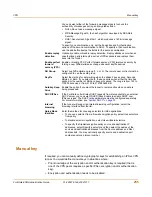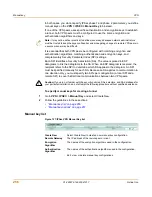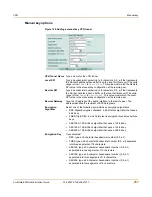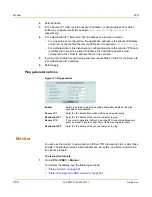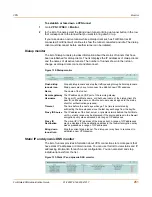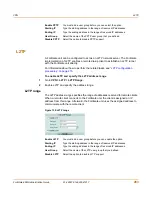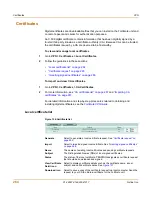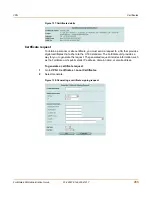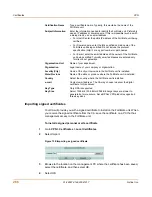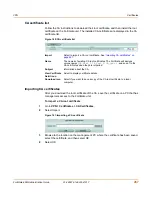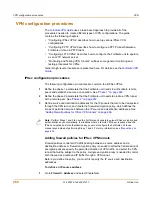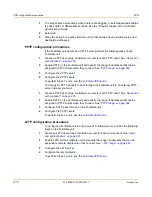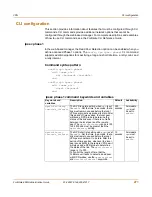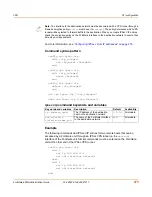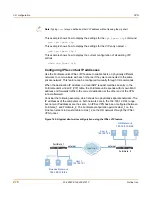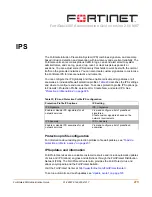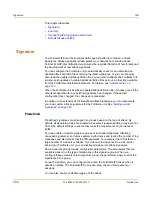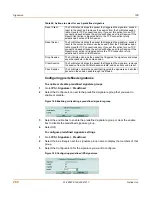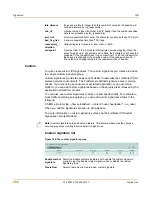
VPN
VPN configuration procedures
FortiGate-60M Administration Guide
01-28007-0144-20041217
269
2
In the Address Name field, type a name that represents the local network, server(s),
or host(s) from which IP packets may originate on the private network behind the local
FortiGate unit.
3
In the IP Range/Subnet field, type the corresponding IP address and subnet mask (for
example,
172.16.5.0/24
for a subnet, or
172.16.5.1/32
for a server or host) or
IP address range (for example,
192.168.10.[80-100]
).
4
Select OK.
To define an IP destination address
1
Go to
Firewall > Address
and select Create New.
2
In the Address Name field, type a name that represents the remote network, server(s),
or host(s) to which IP packets may be delivered.
3
In the IP Range/Subnet field, type the corresponding IP address and subnet mask (for
example,
192.168.20.0/24
for a subnet, or
192.168.20.2/32
for a server or
host), or IP address range (for example,
192.168.20.[10-25]
).
4
Select OK.
To define the firewall encryption policy
1
Go to
Firewall > Policy
and select Create New.
2
Include appropriate entries as follows:
Interface/Zone
Source
Select the local interface to the internal (private) network.
Destination
Select the local interface to the external (public) network.
Address Name
Source
Select the name that corresponds to the local network, server(s), or
host(s) from which IP packets may originate.
Destination
Select the name that corresponds to the remote network, server(s), or
host(s) to which IP packets may be delivered. The name may correspond
to a VIP-address range for dialup clients.
Schedule
Keep the default setting (always) unless changes are needed to meet
specific requirements.
Service
Keep the default setting (ANY) unless changes are needed to meet your
specific requirements.
Action
Select ENCRYPT.
VPN Tunnel
Select the name of the phase 2 tunnel configuration to which this policy
will apply.
Select Allow inbound if traffic from the remote network will be allowed to
initiate the tunnel.
Select Allow outbound if traffic from the local network will be allowed to
initiate the tunnel.
Select Inbound NAT to translate the source IP addresses of inbound
decrypted packets into the IP address of the FortiGate internal interface.
Select Outbound NAT to translate the source address of outbound
encrypted packets into the IP address of the FortiGate public interface.
Summary of Contents for FortiGate FortiGate-60M
Page 12: ...Contents 12 01 28007 0144 20041217 Fortinet Inc Index 369 ...
Page 44: ...44 01 28007 0144 20041217 Fortinet Inc Changing the FortiGate firmware System status ...
Page 74: ...74 01 28007 0144 20041217 Fortinet Inc FortiGate IPv6 support System network ...
Page 82: ...82 01 28007 0144 20041217 Fortinet Inc Dynamic IP System DHCP ...
Page 116: ...116 01 28007 0144 20041217 Fortinet Inc Access profiles System administration ...
Page 234: ...234 01 28007 0144 20041217 Fortinet Inc Protection profile Firewall ...
Page 246: ...246 01 28007 0144 20041217 Fortinet Inc CLI configuration Users and authentication ...
Page 278: ...278 01 28007 0144 20041217 Fortinet Inc CLI configuration VPN ...
Page 340: ...340 01 28007 0144 20041217 Fortinet Inc Using Perl regular expressions Spam filter ...
Page 358: ...358 01 28007 0144 20041217 Fortinet Inc CLI configuration Log Report ...
Page 376: ...376 01 28007 0144 20041217 Fortinet Inc Index ...

